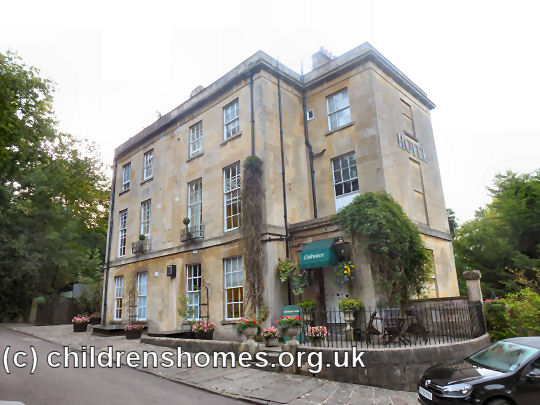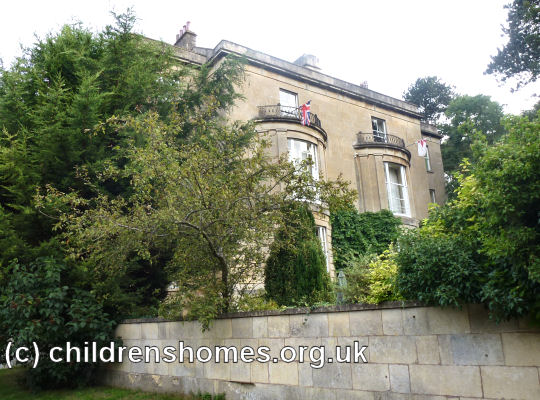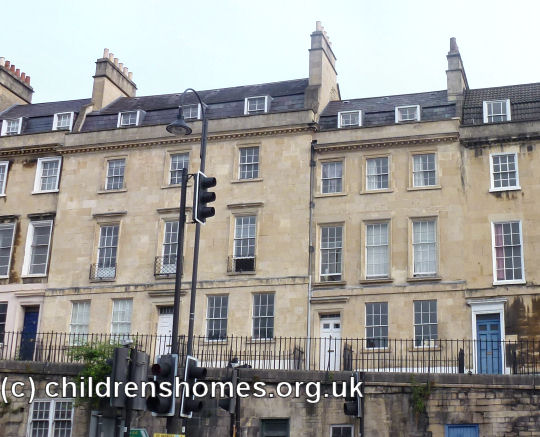Industrial School for Girls, Bath, Somerset
In August, 1870, the Bath Town Council contracted with Miss Mary Dixon, formerly superintendent of the Penitentiary at Salisbury, for her to establish an Industrial School for girls from the Bath area whom magistrates had placed under detention. Miss Dixon was to receive a payment of £50 per annum, with the Council able to take over the running of the School in the event of Miss Dixon's withdrawal due to illness or other eventuality. Premises for the institution were obtained at 2 Bailbrook Lodge, London Road, Batheaston, near Bath, and officially certified for operation on September 22nd, 1870.

Former Industrial School for Girls, Bailbrook Lodge, Bath, 2013. © Peter Higginbotham
An inspection of the School on October 17th, 1872, was far from satisfactory. The premises were in a very untidy condition, and very dirty. The schoolroom was said to be defective both as to space and fittings, and the teaching apparently very unsystematic. It was suggested that more active supervision was needed by the School's managers. It was also noted that A laundry had been fitted up in an out-house communicating with the basement, and the kitchen was being used as a dining-room. The industrial training largely consisted of knitting and needlework, with the older girls being employed in house work and the laundry.

Former Industrial School for Girls, Bailbrook Lodge, near Bath, 2013. © Peter Higginbotham
A year later, matters had considerably improved but the laundry and other facilities were reported as being very confined and inconvenient. An inspection in 1874, however, found serious problems. The School was in a very disorderly state and everything was in confusion. The girls were dirty in appearance, ragged in dress, and in every way neglected. Several were suffering from ophthalmia, all from want of proper care and attention.
After a subsequent inquiry had been conducted by the Council, the School was transferred to a much more suitable property at 17 Walcot parade, Bath, with a complete change of staff. The new premises were certified for operation on April 17th, 1876. The superintendent was now Miss Skinner and the schoolmistress Miss Margaret McCaskell, with a laundress also employed.
As at Bailbrook, the older girls are occupied in the laundry, and the juniors in needlework, cooking, and household management.
In 1878, the School expanded into the neighbouring house at 18 Walcot Parade, which provided a much needed additional day-room, sick-room, and storerooms. The total accommodation was now 80 places. Miss McCaskell had now been promoted to superintendent. The school-room was subsequently enlarged to provided for the additional pupils. From this date, the School's address was often given at 17-18 Walcot Parade or, since the premises incorporated number 16, as 16-18 Walcot Parade.

Former Industrial School for Girls, Walcot Parade, Bath, 2013. © Peter Higginbotham
In 1885, it was reported that a new outdoor shed had been provided to enable exercise to be taken under cover. The girls knitted and darned for the Boys' Industrial Home as well as for themselves. All the girls went for several to the seaside at Clevedon for a change of air.
After Miss McCaskell's sudden death in 1892, Miss Kay took over as superintendent. By 1896, she had been succeeded by Miss Ada L. Noyes. The other staff now comprised Miss Young and Miss Dingwall, teachers; Misses A. and M. Pope, needle and house matrons; and Miss Lewis, laundress.
An inspection report in 1896 noted that the School premises, which consisted of three terraced houses knocked into one, were both cramped and inconvenient. There had been recent improvements, however, with the provision of a bathroom and the brightening of the premises generally. Performance in the classroom was lower than might have been hoped, probably due to the turnover in teaching staff. Mental arithmetic wanted brushing up, and some notion of composition was needed by the upper standard groups. A little singing by ear had been taken, with sol-fa notation planning to be introduced. Domestic economy was also to be added as a class subject. The girls were trained for domestic service, although the inconvenient arrangement of the building had perhaps led to too much rough household work being undertaken. Besides the usual routine in the kitchen, laundry, parlours etc. some f the older girls were being sent to cookery lessons. On fine days, the girls went for a walk in the countryside. Physical drill, lately lapsed, was to be re-introduced. The idea had also been discussed of sending the girls to have swimming lessons. All the girls went to the seaside for a month each year. The doctor called once a fortnight, and oftener if necessary, but did not conduct a quarterly examination. Discipline was said to be maintained with only the lightest of punishments. A mark system was in operation, with good conduct resulting in monetary rewards, half of which the girls were allowed to spend.
In 1898, a dentist examined each girl's teeth and recommended that toothbrushes be supplied. A small amount of washing for private customers was being done in the small laundry which was located in the basement. It was said that there was no difficulty in obtaining suitable places for the girls, the great majority of whom got on very well in service. Swedish drill was carried on. As well as country walks, there were outings to entertainments in the town.
Miss Noyes was still in post in 1920. By 1930, the School had become known as the Walcot Home for Girls. Miss F. Moore was now superintendent.
In 1933, the establishment became an Approved School, one of the new institutions introduced by the 1933 Children and Young Persons Act to replace the existing system of Reformatories and Industrial Schools. The School accommodated up to 55 Junior Girls aged below their 15th birthday at their date of admission. Small boys were also admitted in exceptional circumstances. The children now attended local elementary schools.
From 1940, the institution was known as Avonside School. It was later reclassified as a School for up to 30 Intermediate Girls. In 1966, the headmistress was Miss E.L. Shaw.
In 1973, the School became a Community Home with Education (CHE) under the control of Somerset County Council. Then known as Avonside Special School for Girls, the establishment closed in 1976.
The property has now been converted to private residential use.
Records
Note: many repositories impose a closure period of up to 100 years for records identifying individuals. Before travelling a long distance, always check that the records you want to consult will be available.
- Somerset Heritage Centre, Brunel Way, Langford Mead, Norton Fitzwarren, Taunton TA2 6SF. Has admission registers (1948-73); Punishment book (1954-74); Daily diary (1974-76); Building plans (1962).
- The National Archives, Kew, Richmond, Surrey, TW9 4DU. Has a few reports and other papers.
Census
Bibliography
- Higginbotham, Peter Children's Homes: A History of Institutional Care for Britain's Young (2017, Pen & Sword)
- Mahood, Linda Policing Gender, Class and Family: Britain, 1850-1940 (1995, Univeristy of Alberta Press)
- Prahms, Wendy Newcastle Ragged and Industrial School (2006, The History Press)
Links
- None noted at present.
Except where indicated, this page () © Peter Higginbotham. Contents may not be reproduced without permission.


